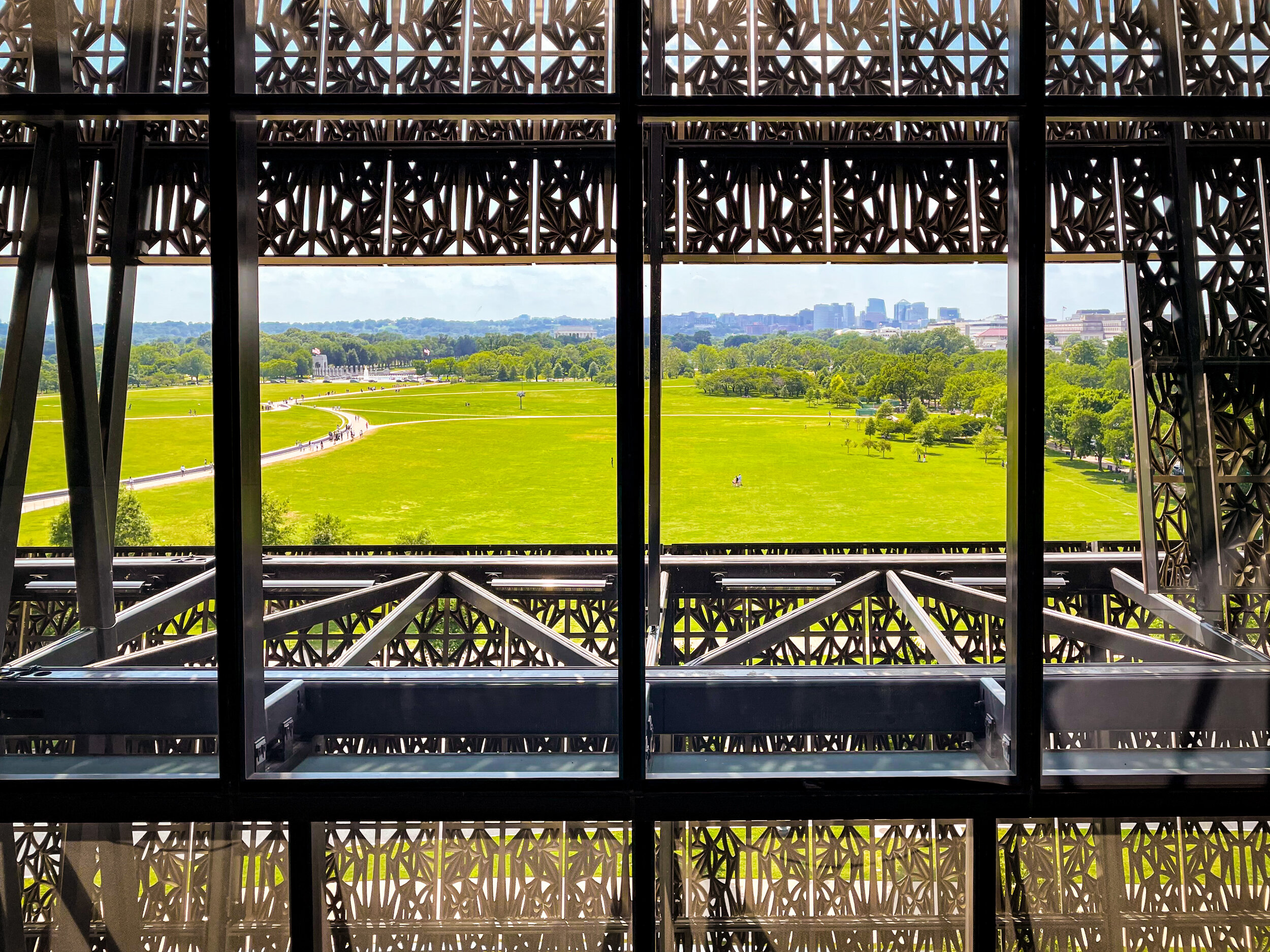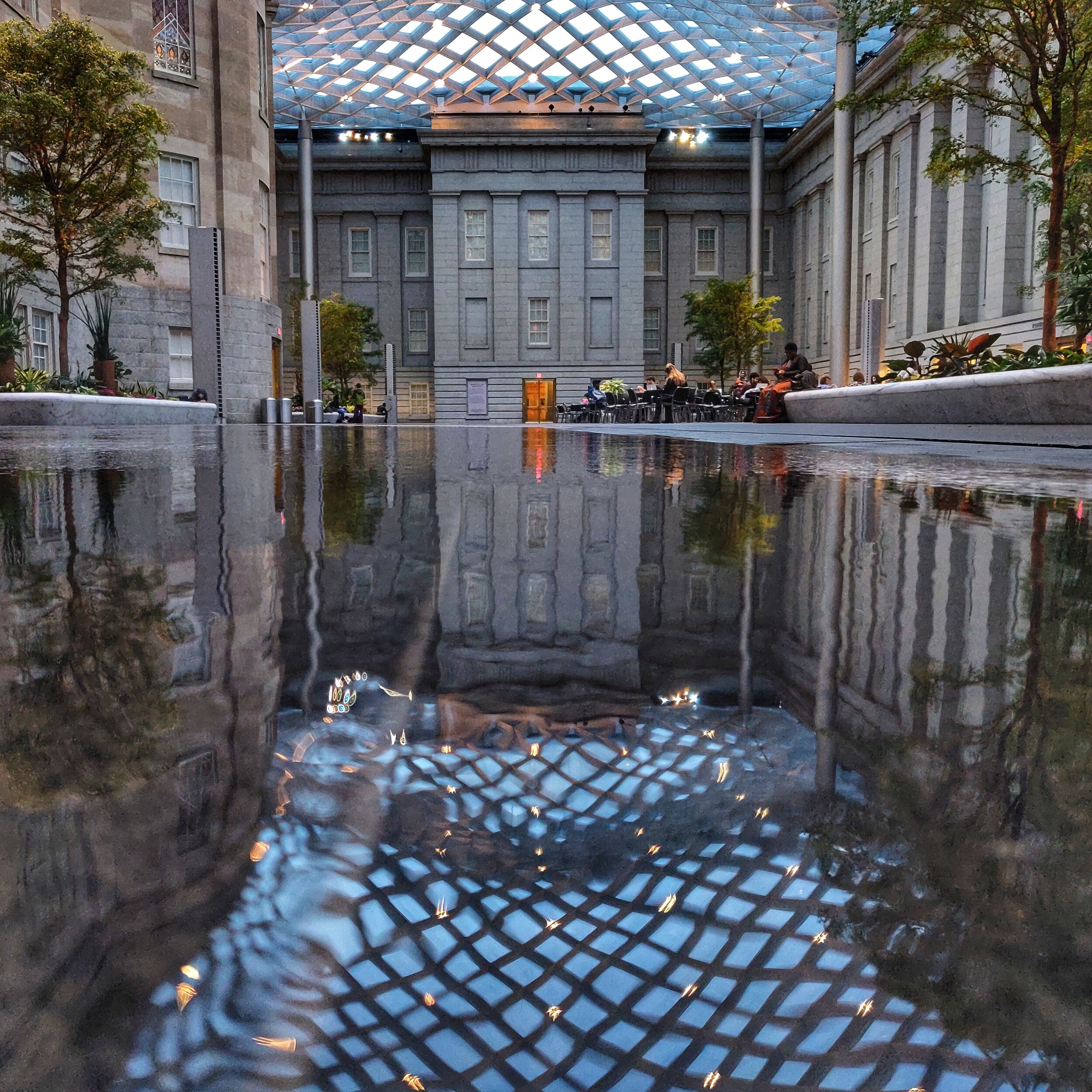View of the National Mall from the National Museum of African American History and Culture.
Museum Landscape: What's Open? (Hint: Quite a Few)
The Kogod Courtyard connects the Smithsonian’s American Art Museum and National Portrait Gallery
Every industry is moving toward reopening at various and disparate paths. Recently, the DC municipal government laid out a path for a near restriction-free reopening of many types of venues in regards to capacity. Museums are included in the new loosening of capacity restrictions, as they are included in the same category with libraries and galleries. As of June 11, museums will no longer be required to impose capacity restrictions. That doesn't mean they aren't able to do so on their own, but the requirement to do so will be shed. Each museum will also open with their own safety procedures in an effort to keep staff and visitors safe. Mask-wearing and distancing guidelines are likely still going to be implemented regardless of the venue type.
A number of Smithsonian museums and a collection of others are opening this Friday (May 14) or next Monday. By June there will be enough museums open to make a full day or two of exploration possible again.
Please check with each individual institution for ticketing options (many will not have walk-up entry), capacity restrictions, open hours & open days, and whether the exhibition you really wanted to see is actually going to be accessible.
Here's the list of DC's major museums and galleries along with their opening status as of today!
Smithsonian Museums
Open now:
Udvar-Hazy Air and Space Center (Virginia location)
Opening very soon:
National Museum of African American History and Culture (May 14)
American Art Museum AND National Portrait Gallery (May 14)
Renwick Gallery (May 14)
National Museum of American History (May 21)
National Museum of the American Indian (May 21)
National Zoo (May 21)
Still closed for now:
National Museum of African Art, National Air and Space Museum (DC location), Anacostia Community Museum, Arts and Industries Building, Hirshhorn Museum, Freer Gallery of Art, National Museum of Natural History, National Postal Museum, Ripley Center, Sackler Gallery, and the Smithsonian Castle.
Non-Smithsonian Museums
Open now:
National Museum of Women in the Arts
National Building Museum
Planet Word
Phillips Collection
International Spy Museum
Opening very soon:
National Gallery or Art; West Building only (May 14)
United States Holocaust Memorial Museum (May 17)
Still closed for now:
National Archives Museum
National Geographic Museum
National World War I Memorial: First Look
One hundred four years after the United States Congress declared war on Germany and entered World War I, the first national World War I Memorial was dedicated in Washington, DC. Known as The Great War or The War to End All Wars, what began as a Europe-centric conflict quickly spread to include sovereign and colonized nations worldwide in Asia, Africa, the Middle East, and the Americas.
After resisting entering the war during his first term as President, Woodrow Wilson eventually asked Congress to declare war against Germany in April 1917, which they did. The war, which began July 1914, ended 19 months later, on November 11, 1918.
4,734,991 U.S. Americans served during World War I. With 116,516 total deaths, it remains one of the deadliest conflicts in United Stated history, leaving only World War II and the Civil War with more total deaths during a single conflict. The new memorial has been years in the making and is unique among war memorials in DC.
See the full 24 photo set on our Attucks Adams Patreon page. That’s also where you will find additional posts featuring interpretation, historical context, and my final observations about this newest addition to the memorial landscape of Washington, DC. A huge thanks to all Patrons for making this work possible!
Frederick Douglass Bridge
Washington Conservatory of Music and School of Expression
902 T Street NW: Former home of the Washington Conservatory of Music and School of Expression
A rarity at the time of its founding in 1903, the Washington Conservatory of Music was a privately owned, Black founded, and Black run arts institution, specifically created for Black adults and children. The Conservatory educated students about African American musical heritage, and also trained them to play, producing top musicians for decades, until closing in 1960.
Black residents in post-civil war DC set out to cultivate their own musical, economic, and educational institutions due to being locked out of the city’s established all-white institutions. The Conservatory is a crucial part of that story and was a major contributor to the “Black Broadway” era of DC history, centered on nearby U Street NW.
Mary Church Terrell’s remarks at the dedication of the Conservatory | Library of Congress
Harriet Gibbs | Oberlin College Archives.
The founder of the Washington Conservatory was Harriet Gibbs. Born in Vancouver, British Columbia to American parents but educated in Ohio including at the Oberlin Conservatory of Music, Gibbs landed in the District of Columbia by 1900. By the time she arrived, she had already traveled the world while studying and performing, and was considered an accomplished pianist with over a decade of experience as a music educator.
Gibbs initially ran the Washington Conservatory of Music from studios inside True Reformer Hall at 1200 U Street NW, just blocks away. By 1904, the institution grew and moved into 902 T Street NW, a stunning and beautiful building donated to the Conservatory by Gibbs’ father.
In addition to musical history, with an emphasis on Black musical history, students at the Conservatory received instruction in strings, piano, voice, pipe organ, and wind instruments, among others. Instruction was a true combination of both Western/European music traditions and African American musical traditions. After a new program was added for rhetorical skills and public speaking, the name of the institution was changed to the Washington Conservatory of Music and School of Expression.
The Conservatory helped consolidate funding for the concert music scene for Black artists in Washington. Previously performances, training, and schooling were sponsored by various institutions including Black churches as well as Howard University.
Advertisement in the Washington Bee, 1910 | Library of Congress.
In the Conservatory’s first years, Gibbs and the other founding faculty tried to strike a balance between student recitals and hosting better known, traveling artists and orators, all while maintaining financial stability as a privately run school. The faculty worked as tirelessly as Gibbs herself.
Early faculty member Emma Azalia Hackley made the long commute from Philadelphia to teach for a full academic year; an assignment she considered a privilege. At the pinnacle of its existence, the Conservatory would host up to 175 students with fourteen faculty members operating out of the T Street building.
One of the early directors of the Conservatory was Mary (aka Mamie) Burrill.
In 1906, Harriet Gibbs married Napoleon Bonaparte Marshall, a famed Harvard graduate, lawyer, and eventual World War I veteran and diplomat. They moved to New York City soon after. Post war, the Marshalls moved to Haiti (1922-1928) when Napoleon received assignment from President Harding. Ever the educator, Harriet Gibbs Marshall founded a school in Port-au-Prince and in 1930, and even authored a book on the history of Haiti, titled The Story of Haiti. She returned her full focus to the Washington Conservatory of Music after her husband’s death n 1933.
In Gibbs Marshall’s absence Burrill, another lifelong educator, ran the school from 1907 through 1911. The first commencement of the Conservatory happened under her tenure in 1910. The ceremony was held at Metropolitan A.M.E. church to an audience of nearly 2,000 people. After serving at the Conservatory, Burrill was likely best known for being a playwright. In 1919, They That Sit in Darkness was first published, landing in Margaret Sanger's Birth Control Review. The one act play is considered to be one of the earliest explicitly feminist plays by a Black playwright. The Conservatory’s success was largely due to the undeniable attraction of talented artists from around the nation, not just as students, but faculty and administration.
I am planning another separate post on Mary Burrill (left) and her partner Lucy Diggs Slowe. Pictured here at their home in Brookland, DC
Capt. Napoleon Bonaparte Marshall. Lawyer, war veteran, athlete, diplomat, and husband of Harriet Gibbs | The American Negro in the World War
In 1941 Gibbs, then known as Harriet Gibbs Marshall, died aged 73 years. While the Conservatory continued under the leadership of her cousin, Josephine Muse, it ultimately closed in 1960 after Muse passed away. The Conservatory’s records and materials live on at Howard University’s Moorland-Springarn Research Center. Both Harriet and Napoleon were laid to rest just a few miles from the old Conservatory at Arlington National Cemetery, Section 4.
The Washington Conservatory of Music and School Expression is not to be confused with the modern (c. 1984) non-profit organization Washington Conservatory of Music located in Bethesda, MD
For more weekly DC history posts, photos, inside access to tour development, and more, support us on Patreon. Plans start at just $3/mo.
Advertisement listed in The Crisis, May 1913
902 T Street NW, former home of the Washington Conservatory of Music and School of Expression.
Read more:
The Washington Conservatory of Music and School of Expression | JSTOR
Cultivating Music in America: Women Patrons and Activists | Univ. of California Press
Harriette Gibbs Marshall | Oberlin College Library
Washington Conservatory of Music | Howard Moorland-Spingarn Research Center
Burrill, Mary P. ( Mamie Burrill) | Oxford African American Studies Center
A reading of Burrill's They That Sit in Darkness. | Triad Stage (Wilmington, NC).



















